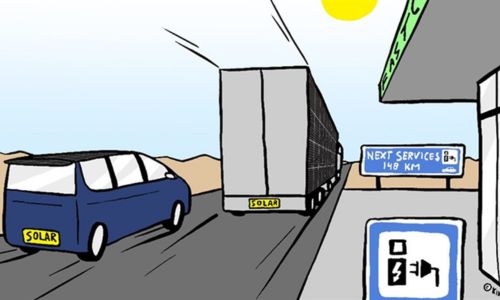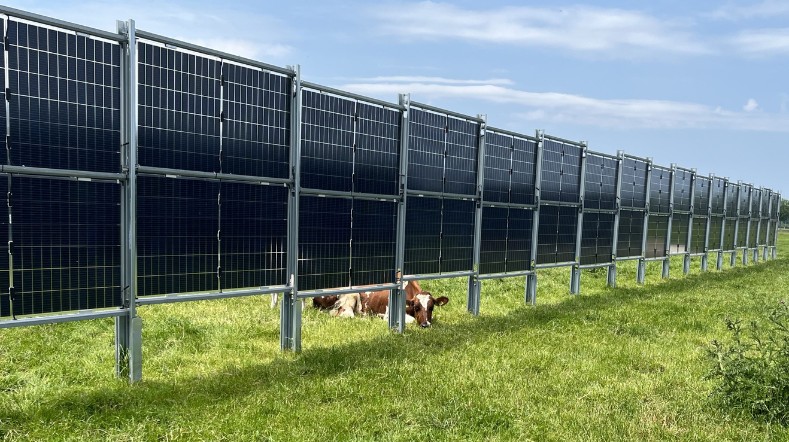
SolarMoves: Solar potential on electric vehicles within Europe
Status project
2023-2026
In cooperation with
Fraunhofer ISE, Sono Motors, IM Efficiency and Lightyear Layer
In the foreseeable future, the majority of vehicles on European roads will be electric, which will increase the stress on the electricity grid. Since the beginning of 2023 a European consortium of experts has been investigating to what extent the expansion of vehicle-integrated photovoltaics would affect the electric power demand of an electrified vehicle fleet (VIPV).
Research on the impact of solar energy on vehicles
Participating in the consortium are the Netherlands Organization for Applied Scientific Research TNO, the Fraunhofer Institute for Solar Energy Systems ISE, and three solar technology suppliers for vehicles: Sono Motors, IM Efficiency, and Lightyear Layer.
The SolarMoves project, commissioned by the Department for Mobility and Transport (DG MOVE) of the European Commission, aims to quantitatively assess solar electricity generation on vehicle bodies and its impact on the future charging infrastructure in Europe.
Monitoring campaign
In the first phase of the project (2023-2024), the Solar Moves consortium focused on the impact of VIPV (vehicle-integrated photovoltaics) at the vehicle level by conducting extensive modelling studies.
This was done by determining typical driving profiles for various vehicle types, examining the impact of VIPV at both vehicle and fleet levels, and assessing the energy demand on the electricity grid compared to electric vehicles (EVs) without VIPV.
Efficiency improvements in the vehicles and PV for future scenarios were calculated. The key findings show that in Southern Europe, VIPV could cover up to 80% of the energy needs of common passenger vehicles. For Central Europe, this would be 55%.
Finally, the effect of VIPV and other efficiency improvements in electric vehicles on the European fleet indicates that a reduction in grid electricity demand of 27 TWh in the EU is possible by 2030.
The study results are now available

"With the measurement campaign, we aim to determine the potential of solar energy in vehicles and make realistic predictions for the required charging infrastructure."
Measurement campaign with electric vehicles across europe
In the second phase of the project, a measurement campaign is initiated to validate the models developed in phase 1. As part of the project, various types of vehicles driving across Europe (including passenger cars, vans, trucks, and buses) are equipped with mobile irradiation sensors.
This way, the amount of sunlight on the vehicle is measured. For some of these vehicles, detailed monitoring of the entire electric energy flow within the vehicle takes place to gain better insight into the charging needs of electric vehicles.
“The results of this measurement campaign provide us with insights into how much the electrical efficiency of electric vehicles improves through the use of integrated solar panels,” says Jan Kroon, solar energy project manager at TNO and project leader of SolarMoves.
“The goal is to determine the total potential of vehicle-integrated solar energy and make realistic predictions about the required charging infrastructure. This is important if a significant portion of electric vehicles is equipped with solar panels."
The results will eventually be used to make several policy recommendations to the European Commission.
Built on a German monitoring campaign
From 2019 to 2023, Fraunhofer ISE investigated the solar potential of German traffic routes in the PV2Go project. In PV2Go, these sensors were installed on 57 cars and 5 trucks belonging to a logistics company as part of a citizen science campaign. The scientists collected and evaluated more than 46 million data points over 460,000 kilometres in the course of a year. Their data analyses showed that the solar energy losses due to shading in a vehicle with roof-integrated photovoltaics and average driving behaviour is around 35 percent.
"Taking these losses into account, electric cars with roof-integrated photovoltaics would generate around 460 kilowatt hours of electricity per year," explained Christian Schill, project manager of PV2GO at Fraunhofer ISE. "With a consumption of 15 kilowatt hours per 100 kilometres, an electric car would gain around 3000 kilometres of range per year."
In the SolarMoves project, the consortium will find out to what extent the results from Germany can be transferred to the EU region.
Growing market
Electric vehicles with solar panels may represent 10% of the entire market in 2030. Several cars with solar cells are in development. Furthermore, already more than 100 truck trailers are driving through Europe, with solar cells on its trailer roof, making commercial transport more sustainable by using solar energy. Next to that, inner-city public transport fleets are already equipped with solar cells to reduce emissions and fuel costs.
Read more about the start of SolarMoves.
Header image: IM Efficiency

Explore the SolarMoves brochure
Get inspired
Wind energy webinars

Carbon footprint floating solar energy systems similar to land systems


SWITCH tackles the energy issues of the future


SWITCH field lab of TNO and Wageningen University & Research/ACRRES opened


Study solar systems in dairy farming launched


